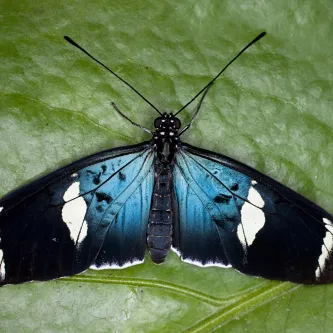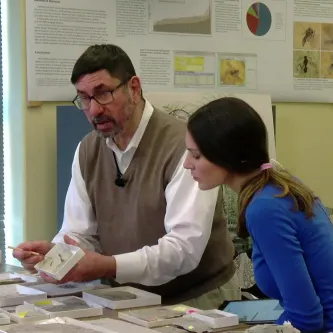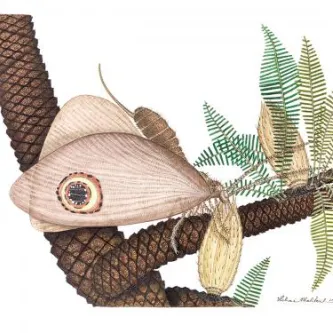Search
Precious Pollinators
Thanks to the Pollinators
We have pollinators — such as bees, butterflies, birds, and bats — to thank for our survival on Earth. Humans depend on plant pollination for many resources, including nearly all the food we eat. For example, a plate of spaghetti with meat sauce requires pollination of the tomato plants and herbs for the sauce, and of the alfalfa to feed the cow that provides the beef. A dessert such as chocolate-covered strawberries requires pollination of strawberry plants by bees and cacao trees by flies. Many medicines are also derived from animal-pollinated flowering plants or developed to mimic compounds discovered in plants. Cotton used in clothes is made from the fluff on the seeds of plants that were bee-pollinated.
What is Pollination?
Pollination is sexual reproduction in plants. Pollen grains contain male sex cells, the equivalent of sperm in mammals, which must get from one flower to another for reproduction to occur. On flowering plants, pollen is on the tops of little stalks (stamens). The female sex cells, eggs, are in ovules at the bottom of vase-like structures (pistils) in the center of the flower. Some plants have just female structures or male structures, but many have both. Pollination happens when a pollen grain reaches an ovule, either on the same plant or another plant of the same species.
How Do Pollen and Ovules Meet Up?
Plants have evolved numerous ways for pollen to make contact with ovules. The most ancient plants (fern-like plants 300 million years ago) relied on wind pollination, and modern conifers and grasses still do. Some conifers have adaptations to increase the chances that wind-scattered pollen reaches its target. For example, when male cones are higher on the tree than female cones, pollen drifts down to the ovules that sit exposed on cone scales. Wind-borne pollen is small and lightweight.
A less common strategy is to move pollen to ovules with water. Some aquatic plants release pollen into the water where it may by chance make contact with its target. Rarely, a plant relies on rainfall to wash pollen from flower to flower.
By far the most common way that pollen reaches ovules is with the help of animals (biotic pollination). Many insect species have adapted, in tandem with plants, specialized pollen-carrying structures. Consider the pollen-trapping hairs on the bodies of bees, specialized into "pollen baskets" on their hind legs. This co-evolution of plants and insects has created more efficient and precise pollen delivery that means a plant can make far less pollen. The insects benefit by using the flowers as a source of food and other rewards for themselves and their offspring. Animal-pollinated flowers produce sugar-rich nectar, protein-rich pollen, fatty oils, and other rewards for their pollinators.
Plants and pollinators have coevolved over millions of years in this win-win relationship. Smithsonian Paleobiologist Dr. Conrad Labandiera studies the evolution of pollination by insects. He has found evidence that ancient gymnosperms (such as conifers) were pollinated by insects called scorpionflies more than 100 million years ago. The long, tubular mouthparts of the fossil scorpionflies appear to be adapted to fit into the funnel-shaped channels of the plants, which contain fossilized drops of liquid, likely nectar.
Strategies for Attracting Pollinators
For biotic pollination to work, a plant must attract animal pollinators. Large, showy, fragrant flowers do the job well. Some flowers have patterned petals that provide guides, like highway median lines, for the pollinator to enter the flower. Orchids have evolved little, sticky, pollen pads that adhere to visiting bees. Bee orchids even mimic the appearance of female bees to attract male bee pollinators. Some wasp-pollinated orchids emit scents that mimic the external hormones (pheromones) of a female wasp.
Many animals besides bees are attracted to flowers. Hummingbirds are drawn to red or orange, tube-shaped flowers that accommodate their long beaks. To attract flies, who eat carrion, flowers tend to be greenish and rotten-smelling. Moths typically pollinate pale flowers that are open at night and have lots of dilute nectar. Bats look for large, fruity-smelling flowers that open at night, such as mango and guava. Beetles tend to prefer flowers with a spicy smell, such as spicebush, and will eat the petals. Unusual pollinators include parrots with brush-like tongues to lap nectar and the blue-tailed day gecko that pollinates palm-like plants on the island of Mauritius.
Pollinators often compete with each other to get nectar rewards from flowers. Over seventeen years, Smithsonian Entomologist Dr. Dave Roubik studied the effect of introduced African killer honeybees on native bees in Mexico. He discovered that, while African killer bees went after the same nectar sources as native bees, the African bees were such abundant and effective pollinators that they boosted the reproduction of the preferred plants. The native bees ended up with a better food supply despite the competition!
Some animals are underappreciated as pollinators. Smithsonian Entomologist Dr. F. Christian Thompson studies flies and has found them to be significant pollinators. Flies pollinate more than 100 agricultural crops, such as onions, strawberries, carrots, apples, lettuce, tomatoes, and buckwheat. It is estimated that less than one tenth of the fly species on the planet, which may include many important pollinators, have even been named. Yet, they may be critical to our food supply.
Pollinators in Peril
Wild populations of many pollinators are declining, for reasons not well understood. Loss of wild pollinators could have a huge impact on world crop supplies. Scientists are working to better understand the causes and consequences, such as climate change impacts on the delicate balance between flowering times and insect activity. Smithsonian Botanist Dr. Gary Krupnick is a member of the North American Pollinator Protection Campaign, a group working on the conservation, protection, and restoration of pollinator habitat in North America. Learn what you can do to help pollinators at the Pollinator Partnership. Or, find ways to get more involved with pollinators at Pollinator Live, a collaboration of organizations that care about pollination, including the Smithsonian National Museum of Natural History.


